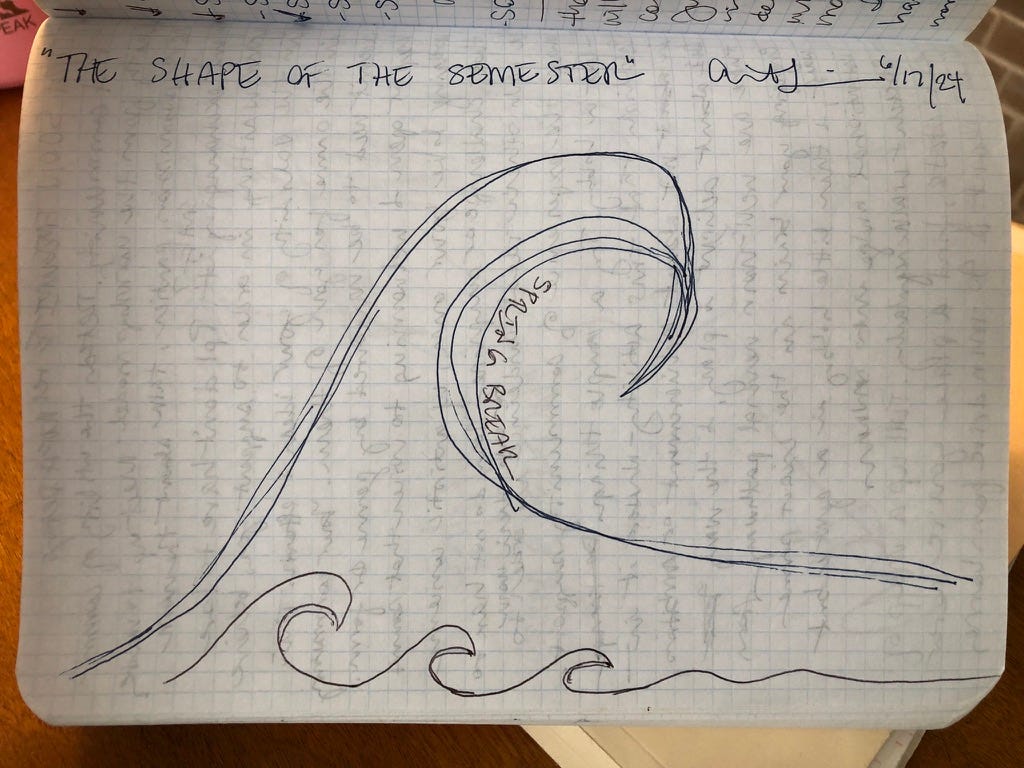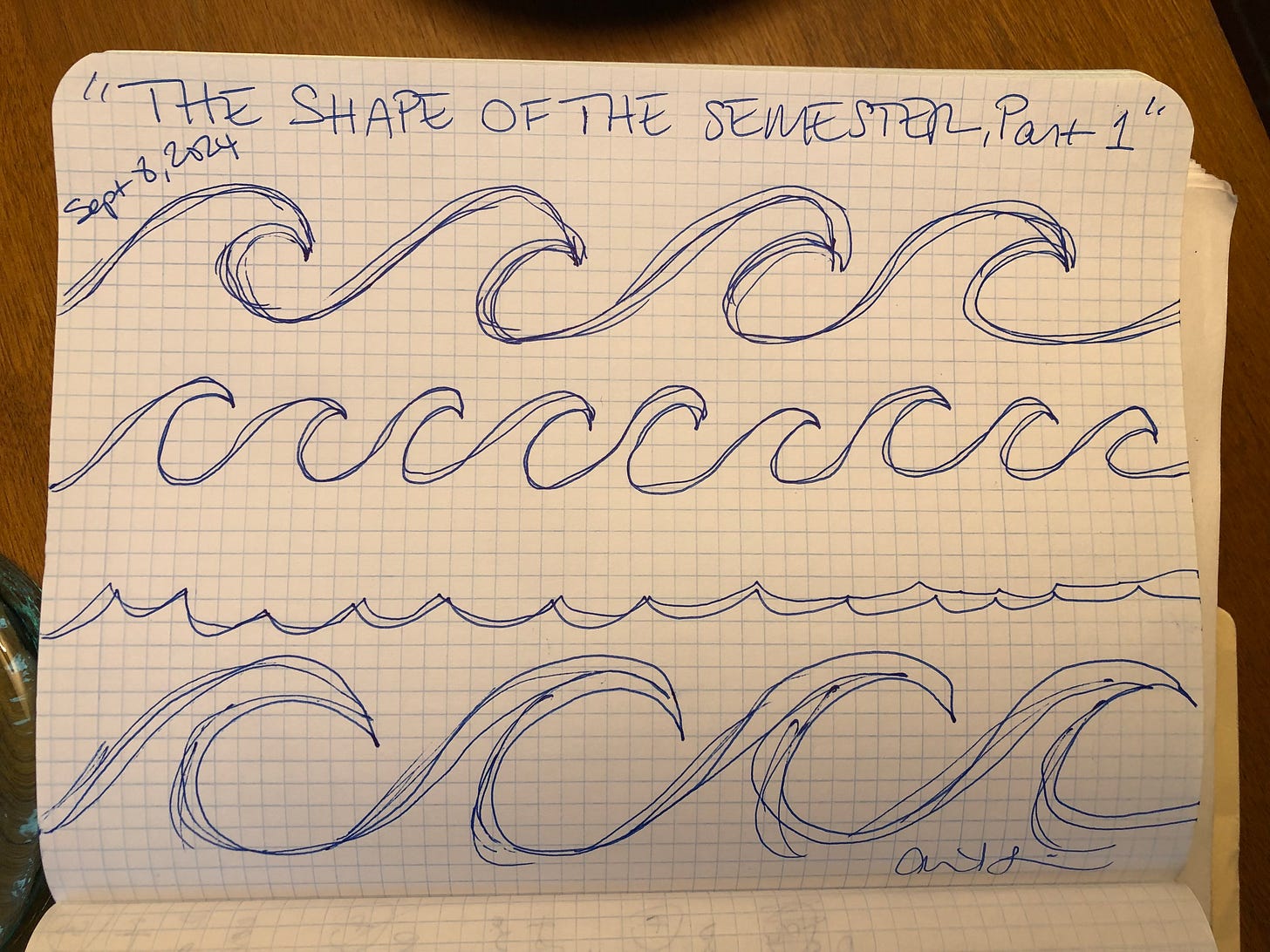SOON, issue 7: The Shape of the Semester #001
How can we--student and teacher--both be free?
Welcome to Something Out of Nothing, a newsletter about meaning—making it, finding it, offering it. I talk about the writing life, teaching, thrifting, books, travel, obsessions and idle interests, and much more.
For the past five years, I’ve taught creative writing, literature, and composition at the college level. Initially, my instincts as a teacher were about creating a rigorous workload, keeping a short tether between my students and the coursework through many accumulative assignments. But I’m an adjunct professor teaching 3-4 different classes across two institutions each semester; the prep and grading required for that kind of “rigor” is unsustainable. I’m always behind. It’s a terrible feeling of being trapped, of having trapped myself.
At the end of every semester, my energy is cratered. I’m angst-ridden and require lots of recovery time that mostly looks like mindless scrolling, bad food, and talking about making better habits. I’m near to the inevitable slide—for self-preservation’s sake—into caring less, trying fewer new things, teaching the same texts ad nauseam and not even caring that I’m bored.
If I’m feeling like this, then I wonder about the other side of the dynamic: my students.
Am I actually scaffolding the coursework, or micromanaging their time?
Am I actually offering dynamic content or refusing to be realistic with what can be thoughtfully realized in a 75-minute class period?
I want to understand: How can so-called rigorous coursework be more about empowerment than depletion? More about my autonomy and my students’ autonomy?
How can we—student and teacher—both be free? Or, at least, freer.
I’ve tried more preparation. I’ve given over whole weeks of unpaid time during the summer in order to prepare for fall semester. Having a fully-loaded Canvas site before the first day of class—due dates, assignments, agendas, files—only helps so much, and the satisfaction is meaningless once the cascade of student work from multiple classes starts piling up. It absolutely does not help—as I mistakenly assumed otherwise—to align due dates across classes. That was convenient only on paper. In life, it was the act of triggering my own personal avalanche.
There’s a lot that can be said about adjunct exploitation in academia. Maybe I’ll write about my experience one day but this essay is not about that. This essay is about reframing my approach to the workload of classroom teaching, and reframing my approach to ideas of rigor and thoughtful coursework, and what that could possibly do for the mind and body.
If I want to feel freer in my life, then I don’t think I can get there by over-assigning work to my students. I don’t think I can require an abundance of their time while determining my own time to be a precious commodity. I want to be and feel freer. I want the same for my students. And I think it will all make for better learning.
When I say the shape of the semester, I don’t know if I’m serious or playing around, but I do like the idea of small, steady waves. Of waters that are steady and navigable.
Now, we’re three weeks into fall semester. I did not do more prep than was absolutely necessary before the first day of class. Some of this, of course, is due to my five years of experience, but I was also setting boundaries around expectations of my time prior to the official start date of my teaching contract(s). For myself, for my students, and in no particular order, here’s what I’m doing differently this semester:
1) I’ve cut coursework by at least a third, compared to previous semesters.
2) Each 75-minute class period is primarily focused on one text or activity, allowing us to circle subjects more slowly, and participate in a couple of different kinds of engagement.
3) Not all reading is required before class. Sometimes, I print copies for the whole class and I read the text aloud while they notate observations according to my guided questions. Thus far, this has shown increased attention and comprehension. Discussion has been much more robust than with texts that I require students to read prior to class.
4) In-class writing prompts are a hefty part of our time together. Prompts can include self-assessments, craft tutorials, further thoughts on assigned readings, or generative original work that tracks back to craft discussions. If you are not in class, then you cannot submit a prompt.
5) To that same end, my classes are now organized with a 40-50% participation grade. This is tracked through in-class work like the writing prompts, discussion groups, workshops, and presentations. You must be present to participate. The remaining grade percentage relies on 3-4 major class assignments.
6) Lastly—and maybe most experimentally—I’ve assigned what I’m calling ‘Field Trips.’ These tasks are out-of-class, independent learning meant to encourage students to explore outside of their frame of reference—an event, hobby, club, movie, album, art show, etcetera—and then report back on their experience in class. My hope is that these Field Trips will allow for more diverse exposure, and diverse exposure will encourage more openness, curiosity, and patience around reading and discussing content that seems unfamiliar or difficult.
7) Okay, truly lastly, I’m responding to email only between 9am-5pm, Monday through Friday. I’ll certainly be grading or prepping outside of those hours, at times, but setting the email boundary is long overdue.
I will circle back with more thoughts in the coming months, sharing how things are going/feeling, what I’ve had to adjust, and what I’ve observed of student engagement. I’ve never written about my teaching life so openly, and it feels vulnerable in a whole different way from talking about my writing life. If you have thoughts about teaching, or what I’m attempting, I’m open to conversation in the comments. Appreciate you being here. xo




April Sopkin is an incredible teacher.